Table of Contents
Introduction
Fed up with living in a concrete jungle? Want to bring a piece of nature into your home? But confused about which indoor plants to choose?
Don’t worry! You’re at the right place.
Indoor plants have become an essential part of modern homes and offices, bringing nature’s beauty indoors while improving air quality and boosting well-being. They can transform any space with their lush foliage, vibrant colors, and unique shapes.
Beyond decoration, many indoor plants help filter harmful toxins, increase humidity, and create a calming atmosphere—making them perfect companions for busy urban lifestyles.
Whether you’re a beginner or a hobby gardener, whether you want to place them in homes or offices, choosing the right indoor plants can bring both joy and health benefits to your environment. In this blog, we’ve discussed 25 of the best indoor plants you can grow, along with their uses and benefits. We’ve covered a wide variety—from easy growers and succulents to crotons, palms, and flowering indoor plants.
To make your selection easier, we’ve also organized them into categories such as flowering indoor plants, Air-Purifying Plants, Low-Maintenance Plants and more at the end of the blog—so you can easily find the perfect match for your space.
So, without further delay, dive into the blog!
Top 25 Popular Indoor Plants
Areca Palm
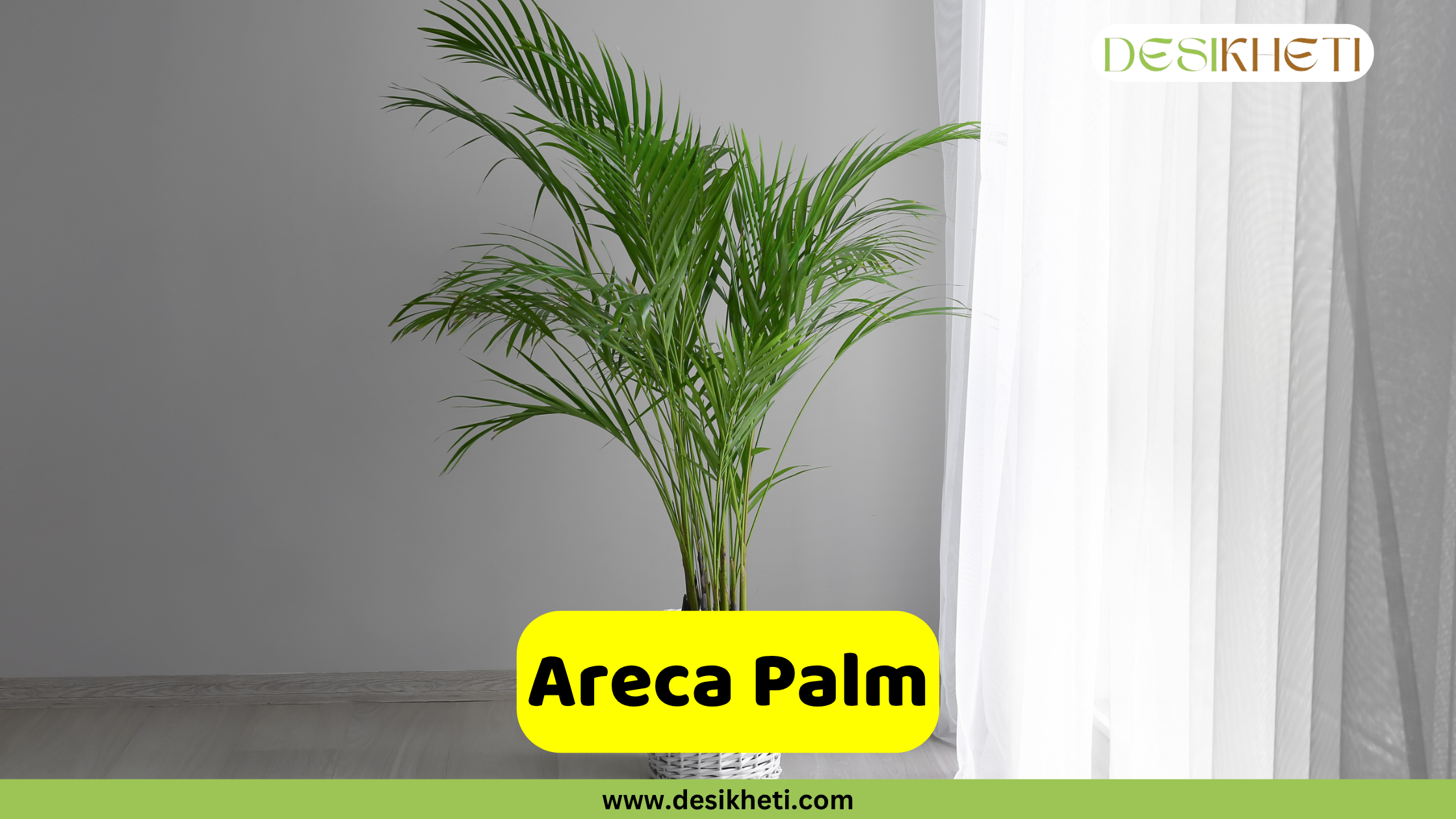
Botanical Name: Dypsis lutescens
The Areca Palm is a graceful tropical indoor plant with multiple cane-like yellow-green stems, topped with feathery, arching fronds. Indoors, it typically grows 6–7 feet tall and prefers high humidity.
Place it in a bright, well-lit area away from direct sunlight. Avoid harsh direct sun, as it can scorch the fronds.
Want to explore more Palm Tree varieties? Read: 15 Types of Palm Tree Varieties That Beautify Your Home
Benefits
- Acts as a natural air purifier, removing toxins like formaldehyde, benzene, and carbon monoxide
- Increases indoor humidity, which benefits skin and respiratory health
- Generally non-toxic to humans and pets
Snake Plant
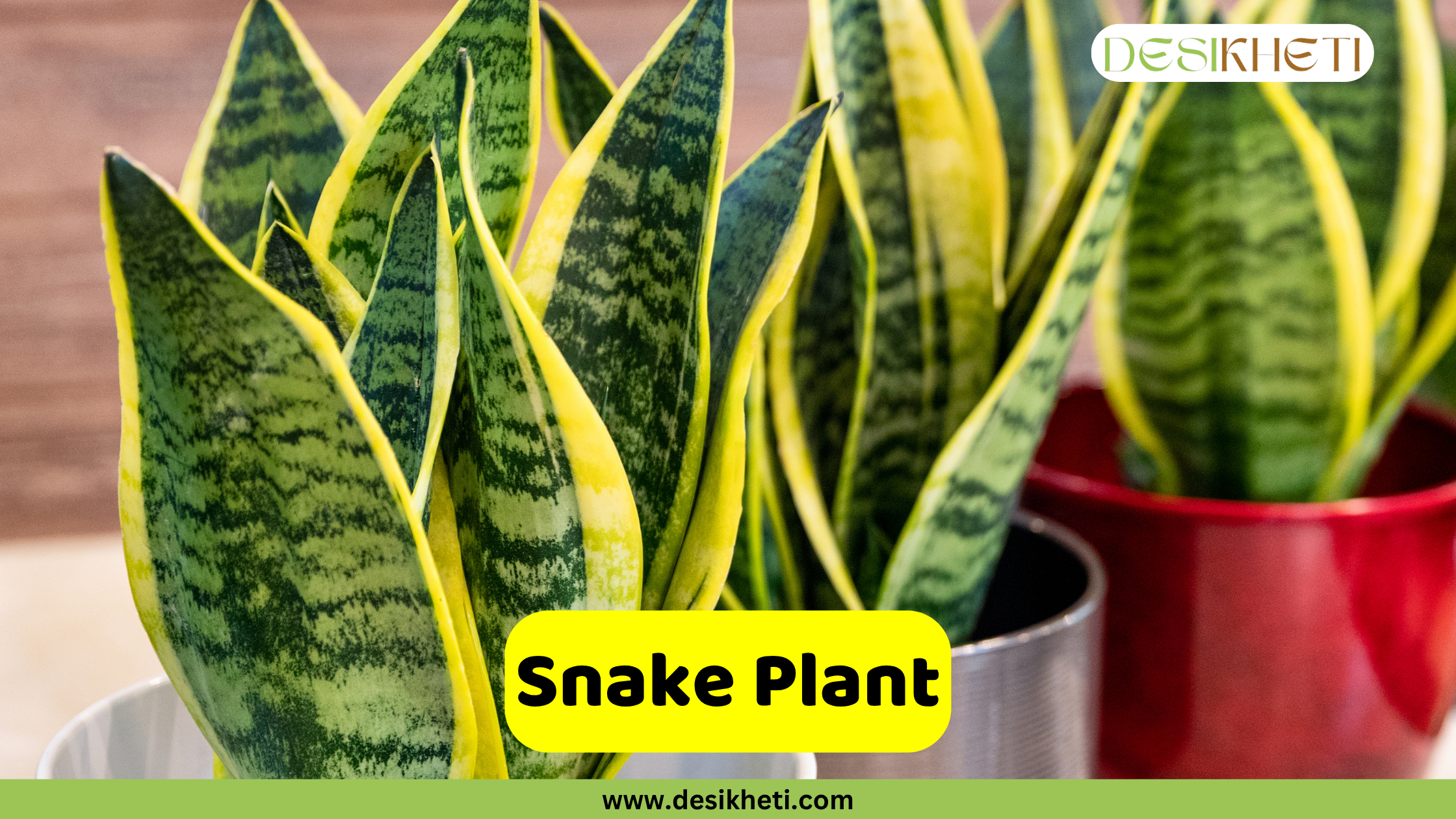
Botanical Name: Dracaena trifasciata
Known for its upright, sword-like leaves with striking green patterns and yellow or light-green edges. The Snake Plant grows slowly and typically reaches 1.5 to 4 feet in height. It is one of the toughest houseplants and thrives on minimal care.
Performs best in bright, filtered light but can survive in low-light conditions, such as dim corners. Avoid strong direct sunlight, as it can cause leaf burn.
Want to explore more snake plant varieties? Read: 15 Types of Snake Plants for Your Garden
Benefits
- Filters indoor air by removing toxins like formaldehyde, benzene, and xylene
- Releases oxygen at night, making it ideal for improving bedroom air quality
- Extremely low-maintenance and perfect for beginners
Toxicity
- Toxic to pets and humans if ingested. Keep out of reach of children and animals.
Interesting Fact
Commonly known as Mother-in-law’s Tongue due to the sharp, pointed shape of its leaves, which resemble a tongue and humorously symbolize the sharpness or cutting nature often associated with a mother-in-law’s words.
ZZ Plant
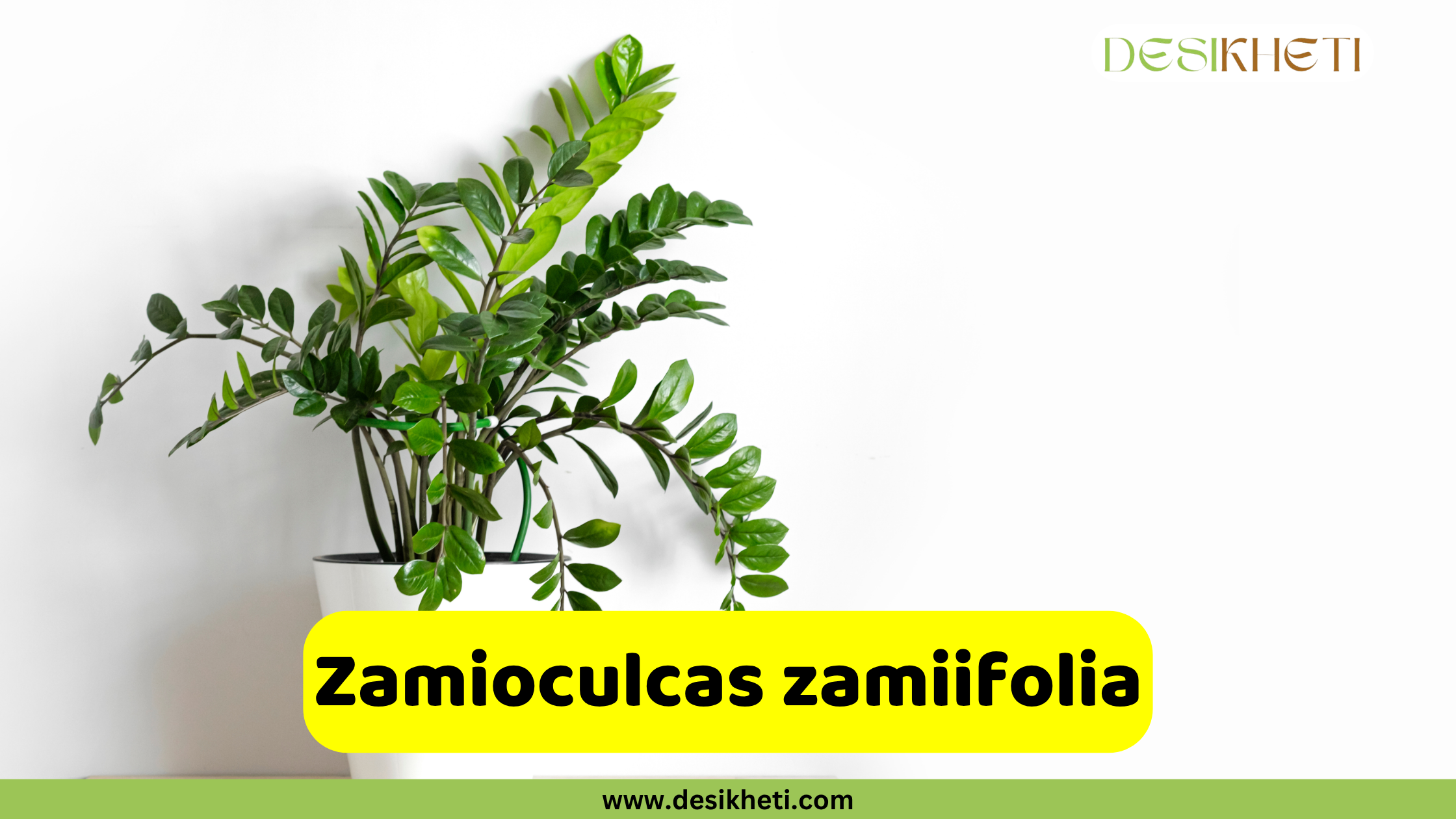
Botanical Name: Zamioculcas zamiifolia
This stylish, slow-growing plant has thick, glossy, oval leaves that grow upright. It typically reaches 2–3 feet indoors. The ‘Raven’ variety is notable for its deep purple-black foliage.
Prefers bright, indirect light but tolerates low-light conditions well. Avoid direct sunlight. Water only when the soil is completely dry.
Benefits
- Cleans indoor air by removing pollutants like xylene and toluene
- Requires very little water and attention great for busy or forgetful plant parents
- Offers a modern aesthetic with glossy foliage
Toxicity
- Mildly toxic if ingested; keep away from children and pets.
Interesting Fact
The Money Plant is commonly called Devil’s Ivy because it is almost impossible to kill even when kept in very low light or neglected. Like the “devil,” it’s tough to get rid of, and the “ivy” refers to its climbing, vining growth habit. So, if you are a beginner or very busy, this plant might be a good option.
Aloe Vera
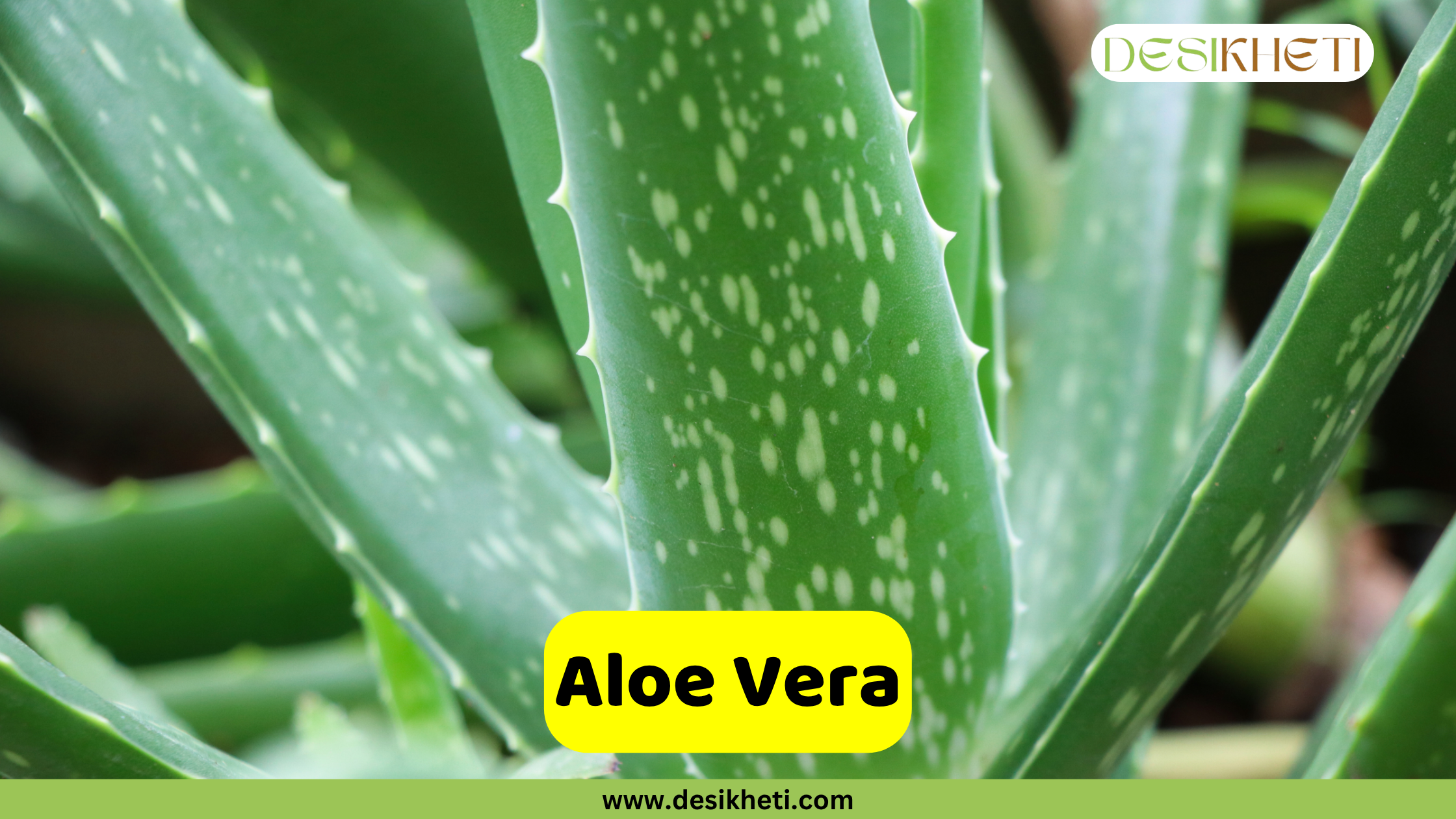
Botanical Name: Aloe barbadensis
A succulent plant with thick, fleshy, serrated green leaves arranged in a rosette shape. It stores water in its leaves, making it drought-tolerant and ideal for dry indoor climates. It usually grows 1–2 feet tall indoors.
Prefers bright, indirect light. Water sparingly and allow the soil to dry between waterings.
Want to explore more Succulent plant varieties? Read: 15 Best Succulent Plants
Benefits
- Gel is used to treat burns, cuts, and skin irritations
- Purifies air by removing benzene and formaldehyde
- Low-maintenance, pest-resistant, and decorative
Toxicity
- The latex under the leaf skin can be toxic if ingested.
Rubber Plant

Botanical Name: Ficus elastica
Features large, glossy, leathery leaves in deep green or variegated cream/yellow hues. New leaves often appear reddish. It has a sturdy, upright stem and can grow 6–10 feet indoors, resembling a small ornamental tree.
Place in a spot with bright, indirect light. It can tolerate mild morning sun but avoid strong afternoon sun. Water when the top 1–2 inches of soil are dry; reduce watering in winter. Prefers temperatures.
Benefits
- Filters airborne toxins like formaldehyde and benzene
- Makes a bold visual statement with large, glossy foliage
- Grows quickly and is relatively easy to maintain
Toxicity
- Sap can cause skin or eye irritation. If ingested by pets, the plant can cause vomiting, drooling, and other symptoms. Keep out of reach of children and pets.
Boston Fern

Botanical Name: Nephrolepis exaltata
A lush fern with finely divided, bright green fronds that cascade gracefully. Ideal for hanging baskets or pedestal stands. Grows 1–3 feet in height and spread.
Generally best placed near an east-facing window with bright, indirect light. Tolerates partial shade but not direct sun. Soil should stay moist; maintain high humidity with misting or humidity trays.
Want to explore more Fern varieties? Read: 15 Best Fern Varieties to Grow in Your Garden
Benefits
- Filters formaldehyde and xylene naturally
- Adds humidity, beneficial for skin and respiratory health
- Creates a lush, tropical indoor atmosphere
Also read – 25 Best Indoor Flowering Plants
Chinese Evergreen
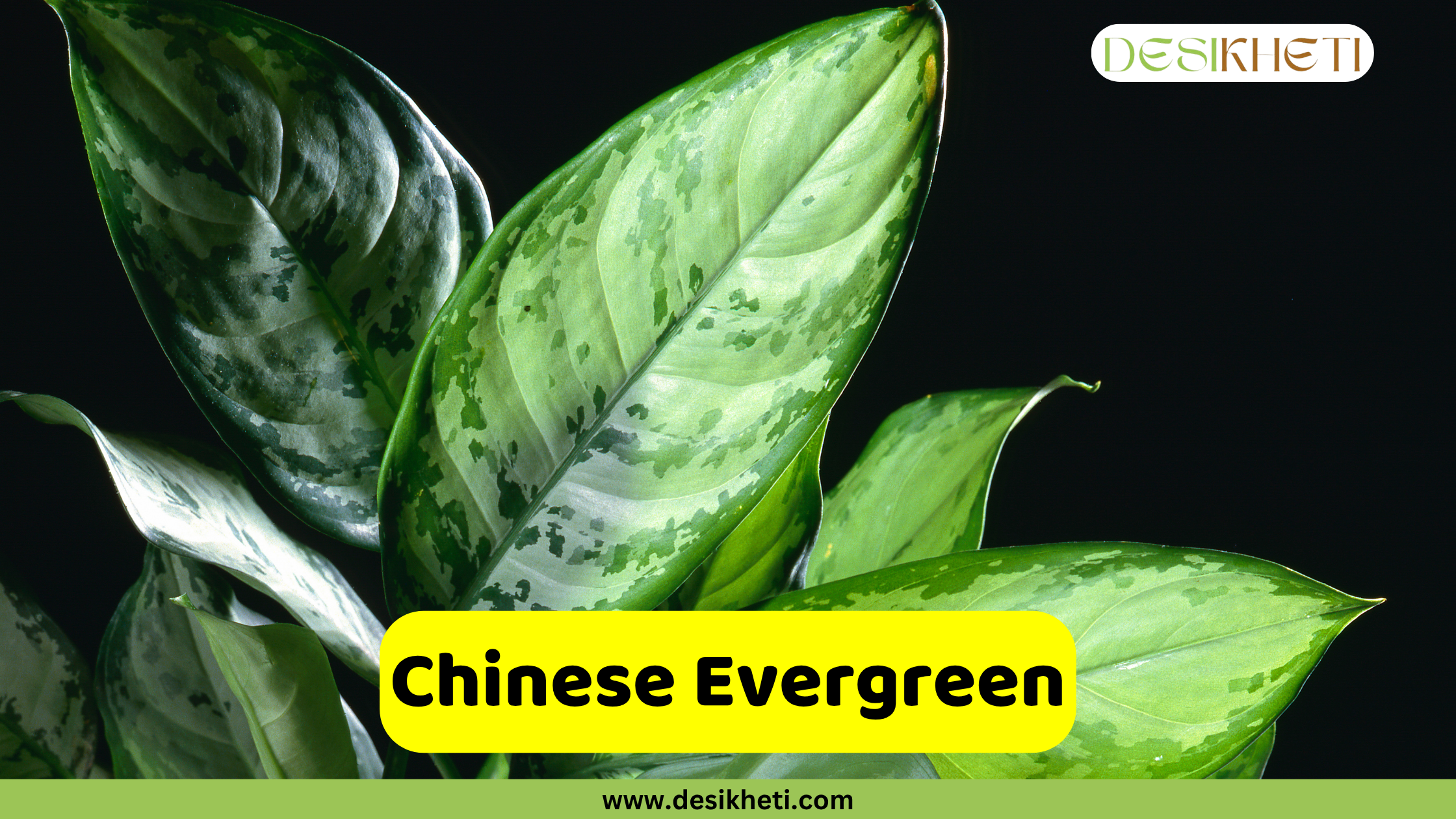
Botanical Name: Aglaonema modestum
A compact, bushy plant with deep green, lance-shaped leaves decorated with silver or light green patterns. It grows slowly, typically reaching 1–3 feet tall, making it ideal for desks and corners.
Prefers low to medium indirect light. Avoid direct sunlight. Water when the top inch of soil dries out. Thrives best in moderate humidity.
Benefits
- Filters indoor pollutants like benzene and formaldehyde
- Thrives in low light and requires little care
- Enhances decor with vibrant patterned leaves
Toxicity
- Mildly toxic; may cause mouth irritation or vomiting if ingested.
Fiddle Leaf Fig
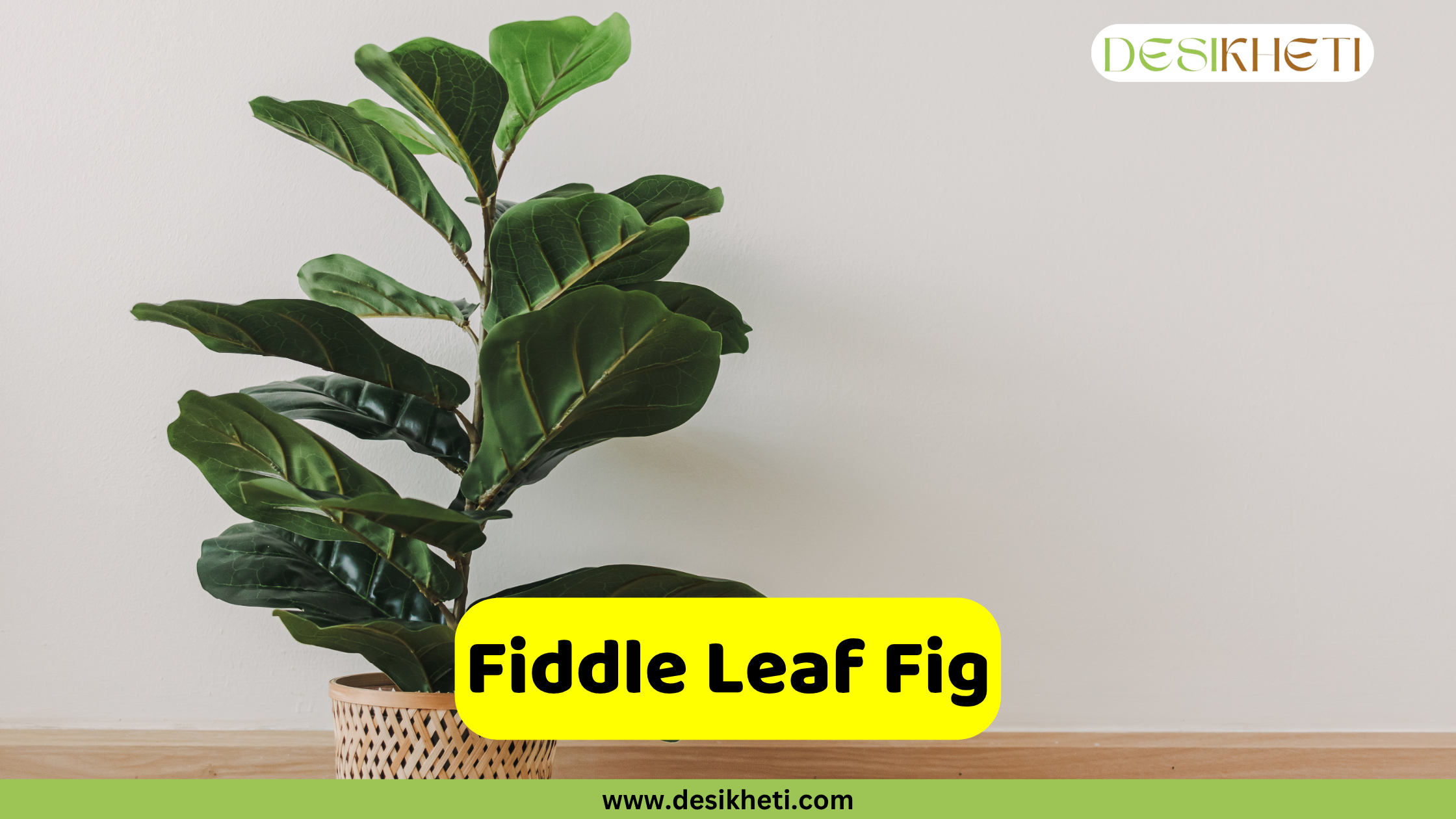
Botanical Name: Ficus lyrata
Known for large, fiddle-shaped leaves with prominent veins and a glossy texture. It can grow 6–10 feet tall indoors. Popular for modern or minimalist décor.
Prefers bright, indirect light. Can tolerate mild morning sun but avoid intense afternoon sun. Use well-drained soil. Water when the top inch of soil dries out. Ideal temperature with moderate to high humidity.
Benefits
- Adds dramatic greenery, elevating interior design
- May improve mood and productivity
Toxicity
- Sap may irritate skin or mouth. Toxic to pets, causing vomiting and drooling if ingested.
English Ivy
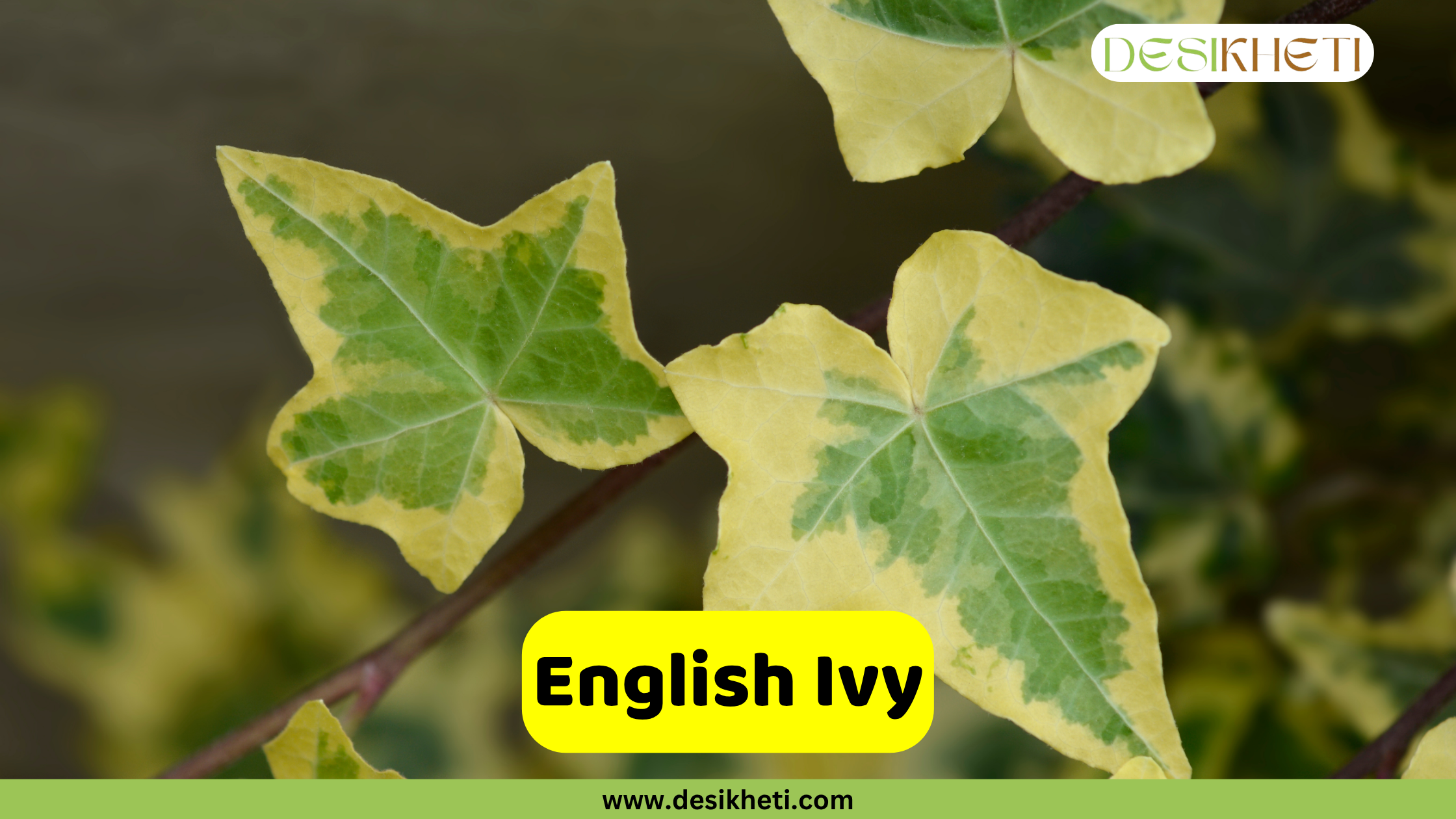
Botanical Name: Hedera helix
A fast-growing trailing or climbing vine with glossy green leaves, often variegated with cream, yellow, or white. Can grow up to 6–8 feet indoors with support and is commonly used in hanging baskets or trained on trellises.
Tolerates low light, but variegated varieties need more light to retain their color. Water when the top inch of soil is dry. Prefers cool temperatures and moderate to high humidity.
Benefits
- Removes mold, benzene, and formaldehyde from indoor air
- Offers versatile décor as a hanging, climbing, or trailing plant
- Low maintenance and suitable for beginners
Toxicity
- Toxic to pets and humans; may cause vomiting or irritation if ingested.
Bamboo Palm
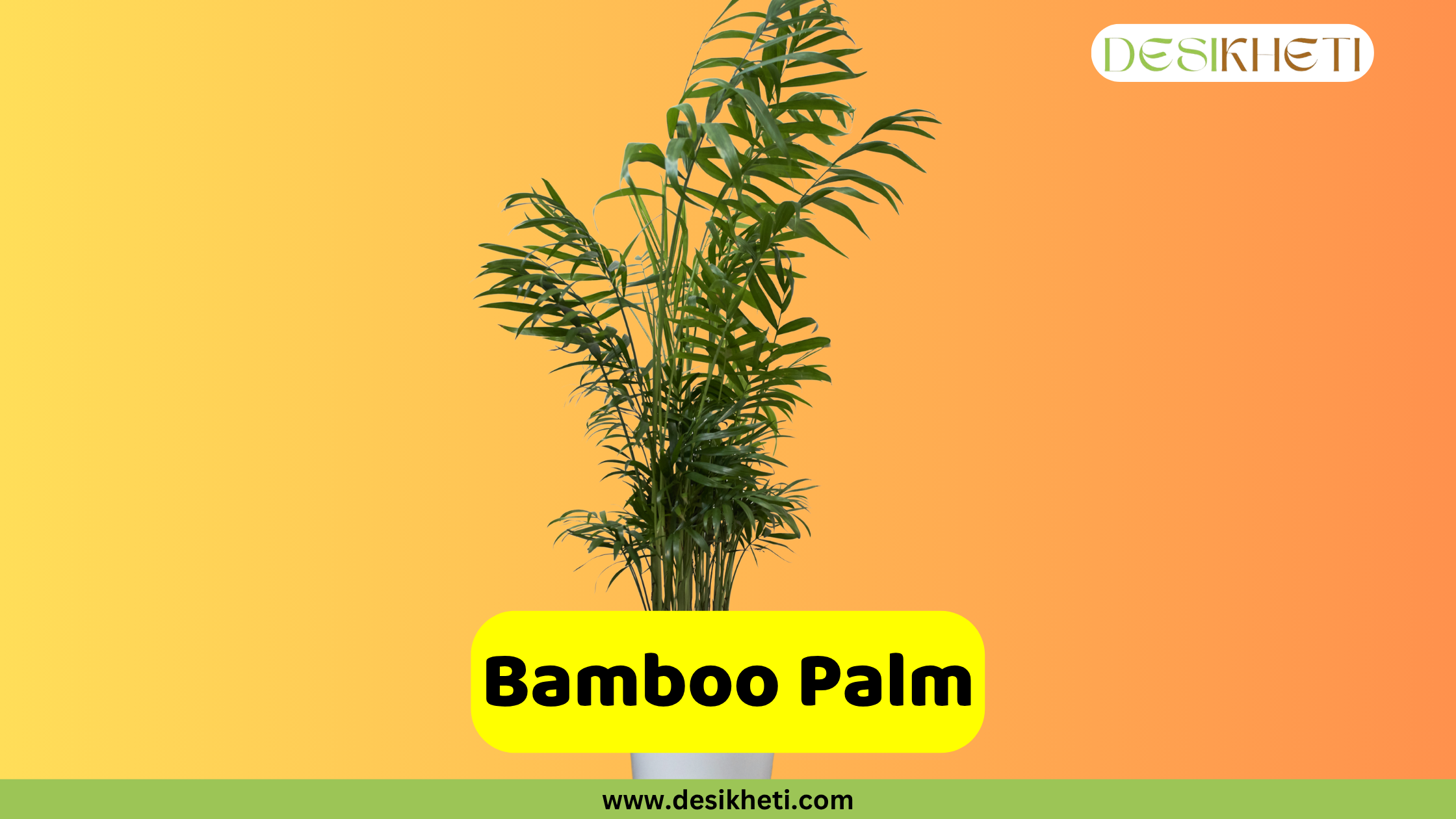
Botanical Name: Chamaedorea seifrizii
A graceful plant with thin, bamboo-like stems and feathery green leaves. Its clumping growth habit and upright form make it a great choice for adding a tropical feel to indoor spaces. Typically grows 4–6 feet tall indoors.
Thrives in bright, indirect light, though it can tolerate lower light levels. Avoid direct sunlight, as it can scorch the leaves. Keep the soil evenly moist and provide moderate to high humidity.
Want to explore more Palm Tree varieties? Read: 15 Types of Palm Tree Varieties That Beautify Your Home
Benefits
- Filters pollutants like formaldehyde, benzene, and carbon monoxide
- Adds lush, tropical appeal to interior spaces
- Beginner-friendly
Lucky Bamboo
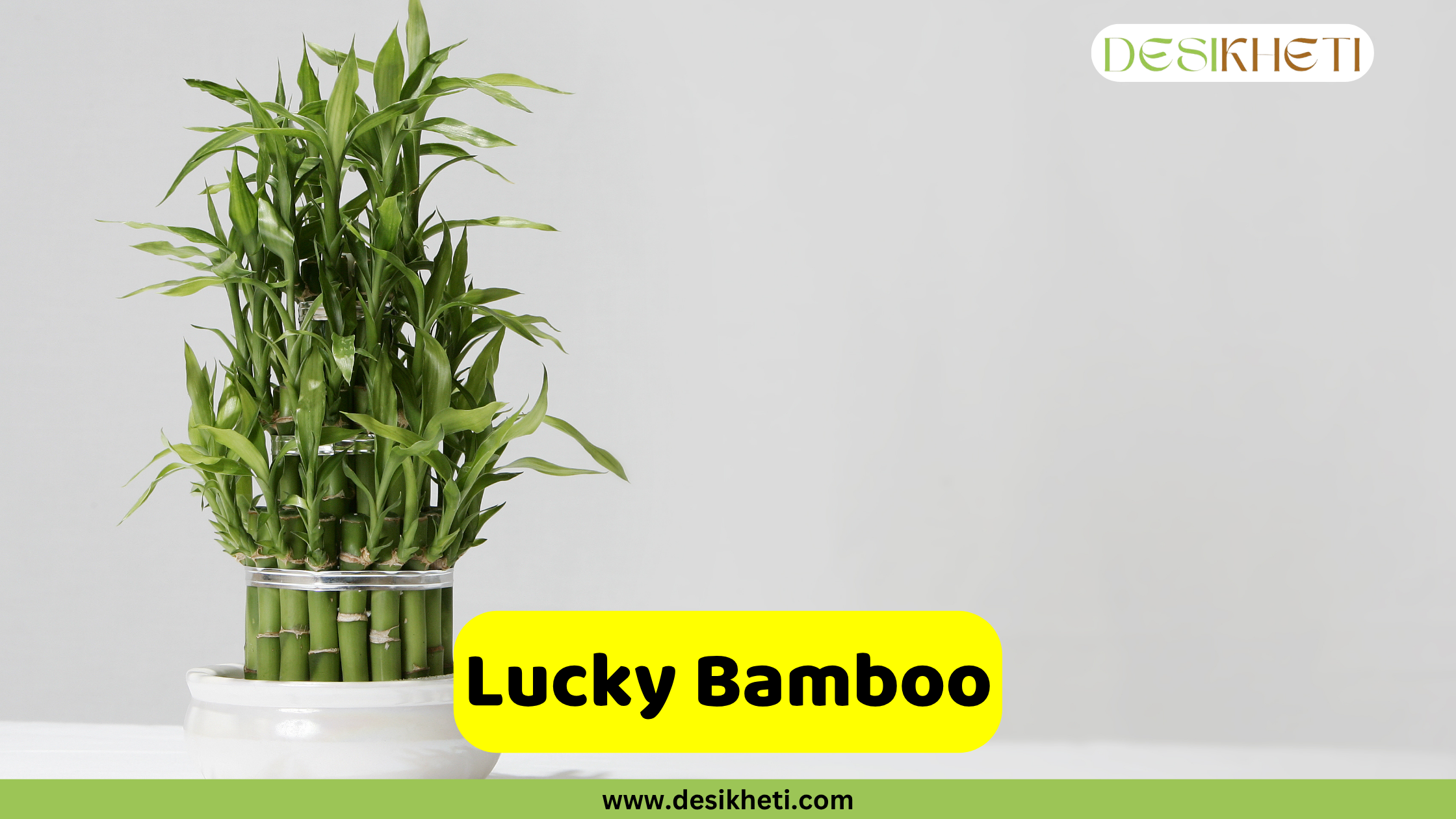
Botanical Name: Dracaena sanderiana
An attractive plant with smooth, green stalks that are often curled or braided, topped by narrow, lance-shaped leaves. It can grow 1.5 to 5 feet tall indoors, depending on the growing setup. Popular for being grown both in water and soil.
Avoid direct sunlight, which can scorch the leaves. When grown in water, use distilled or filtered water and change it every 7–10 days. When grown in soil, keep the soil slightly moist but well-drained.
Want to explore more Palm Tree varieties? Read: 15 Best Types of Bamboo to Grow in Your Garden
Benefits
- Regarded as a Feng Shui symbol of luck, wealth, and prosperity
- Provides light indoor air purification (less effective than other Dracaena species)
- Visually striking with its sculpted shapes, ideal for desks or tabletops
Toxicity
- Toxic to pets; may cause vomiting, drooling, or lack of appetite if chewed or ingested.
Spider Plant
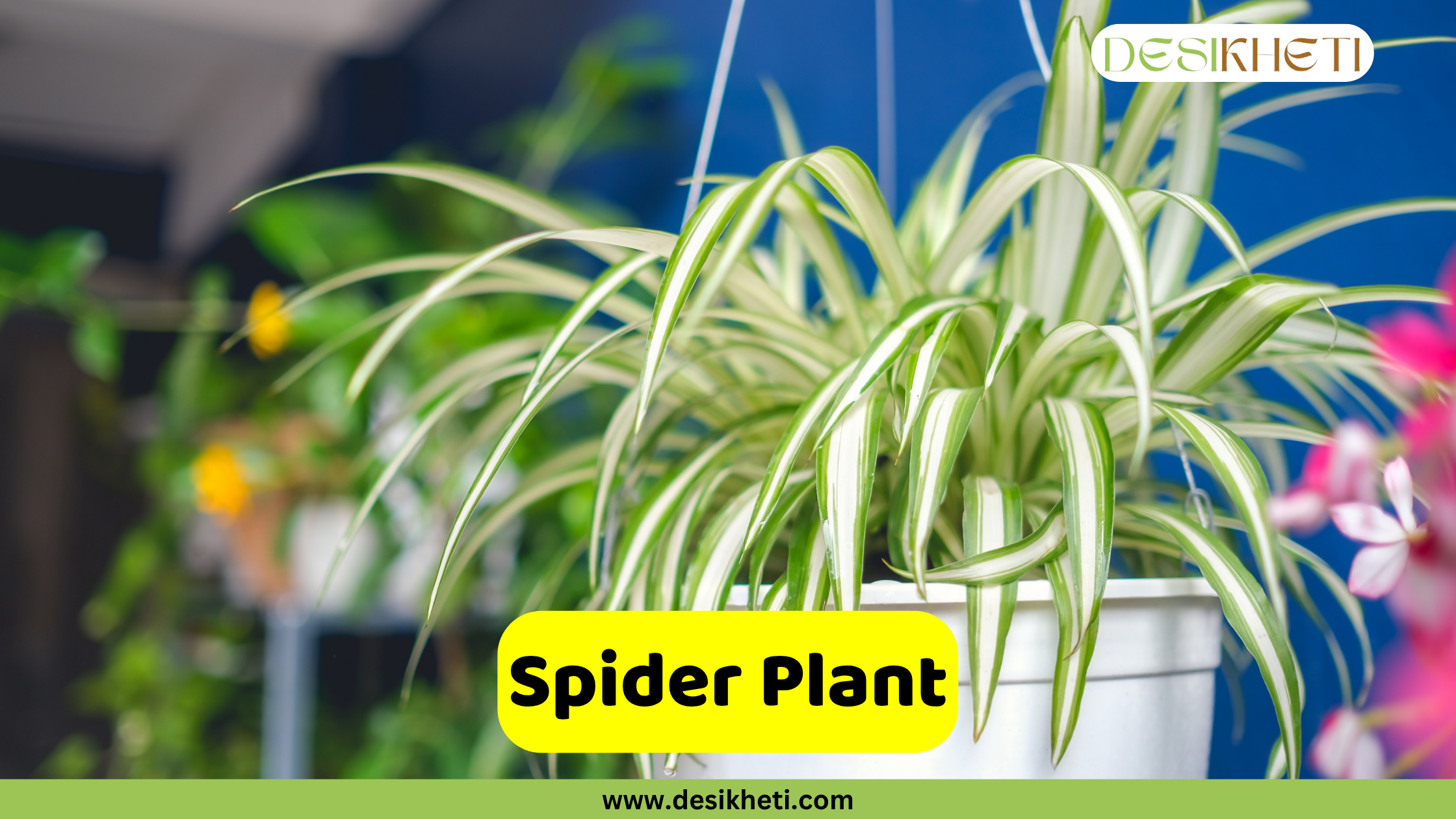
Botanical Name: Chlorophytum comosum
A low-maintenance plant with arching green leaves striped with white or yellow. It produces small white flowers and baby offshoots, or “pups,” on long runners. Typically grows 12–15 inches tall indoors.
Thrives in bright, indirect sunlight. Can tolerate low light, but direct sun may scorch the leaves.
Benefits
- Filters indoor air by removing pollutants like formaldehyde and xylene
- One of the easiest plants to grow perfect for beginners
- Visually appealing with its cascading baby plants
Prayer Plant
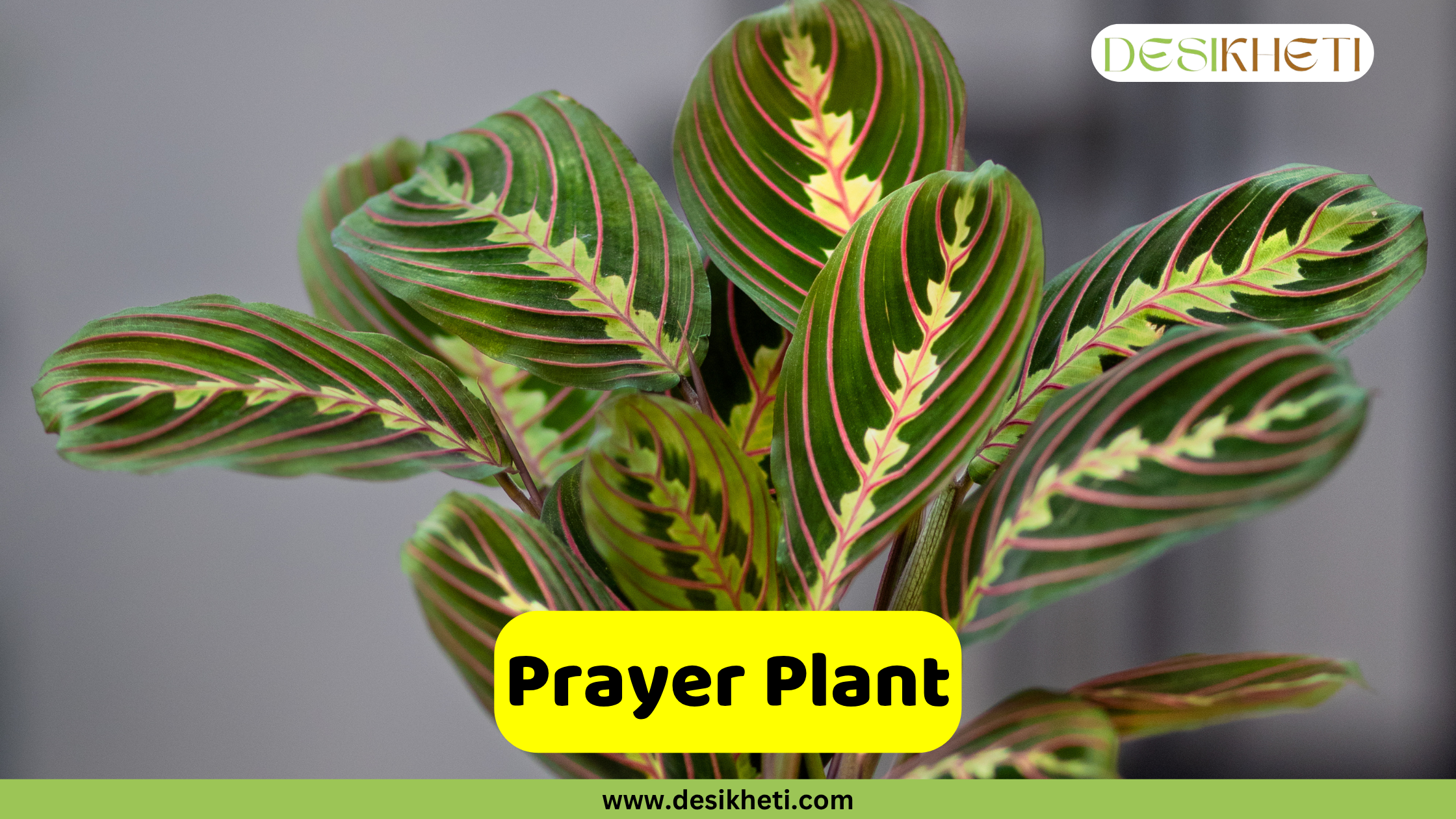
Botanical Name: Maranta leuconeura
A compact plant (12–18 inches tall) with oval, deep green leaves featuring bright red or pink veins in a marbled pattern. This plant is known for its unique habit of folding its leaves upward at night, resembling praying hands. Occasionally produces small white or purple flowers.
Place in an area with bright, indirect light. Avoid direct sunlight to prevent leaf burn. Keep the soil consistently moist but not soggy, allowing the top inch to dry out slightly between waterings.
Benefits
- May improve air quality by absorbing indoor pollutants
- Striking, colorful foliage enhances interior aesthetics
- Ideal for beginners; relatively low-maintenance
- Fascinating leaf movement adds an interactive visual feature
Bird’s Nest Fern
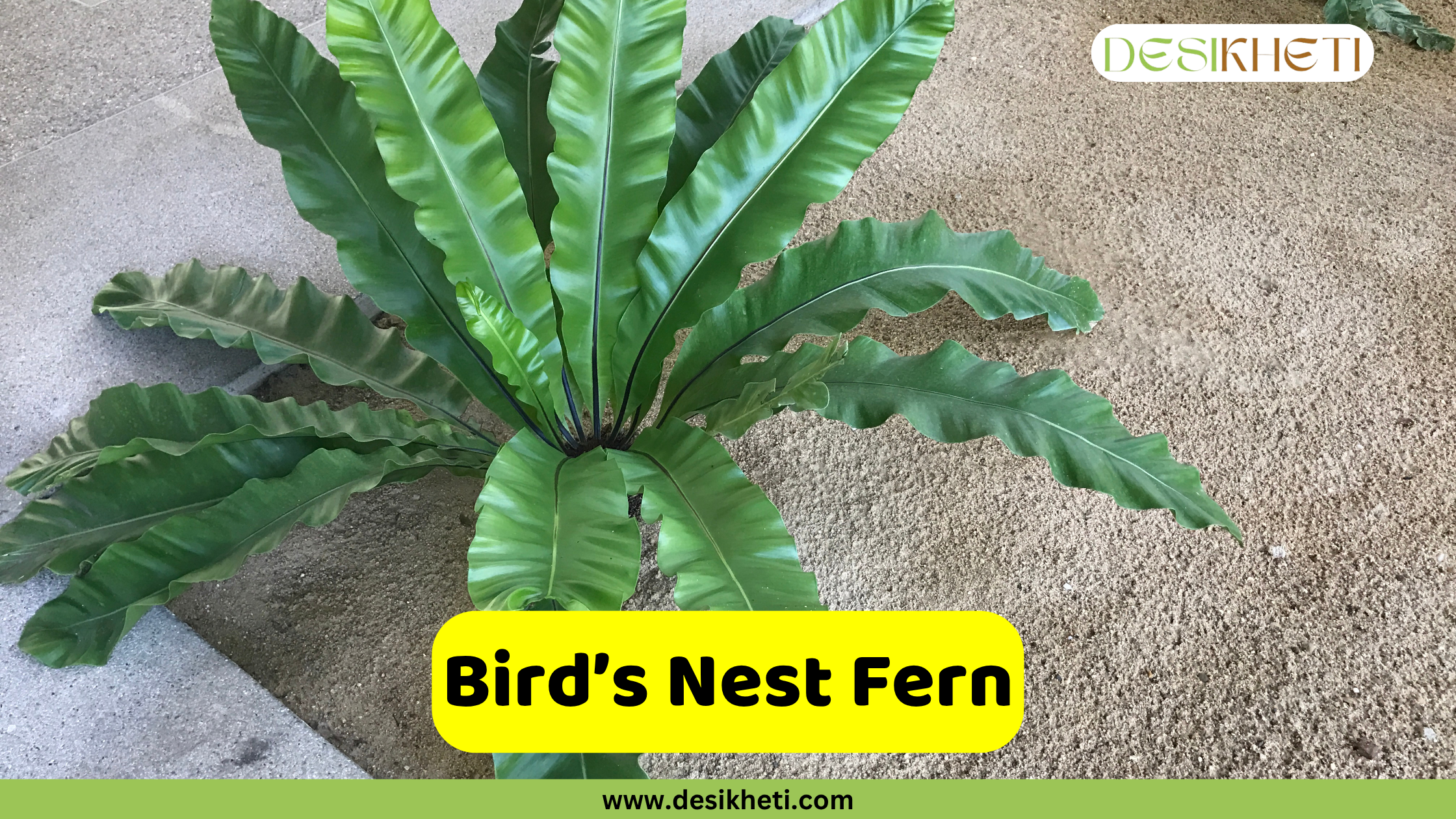
Botanical Name: Asplenium nidus
Features long, leathery, wavy-edged fronds radiating from a central rosette, giving the appearance of a bird’s nest. Grows 1–2 feet tall indoors. Offers a bold, tropical aesthetic without being overly demanding.
Prefers medium to bright indirect light. Avoid direct sunlight. Water every 1–2 weeks, letting the soil dry halfway between waterings. Don’t water the center to avoid rot.
Want to explore more Fern varieties? Read: 15 Best Fern Varieties to Grow in Your Garden
Benefits
- Adds a rich, tropical look to any room
- May help filter indoor air pollutants
- Low maintenance, with minimal pruning needed
Baby Rubber Plant
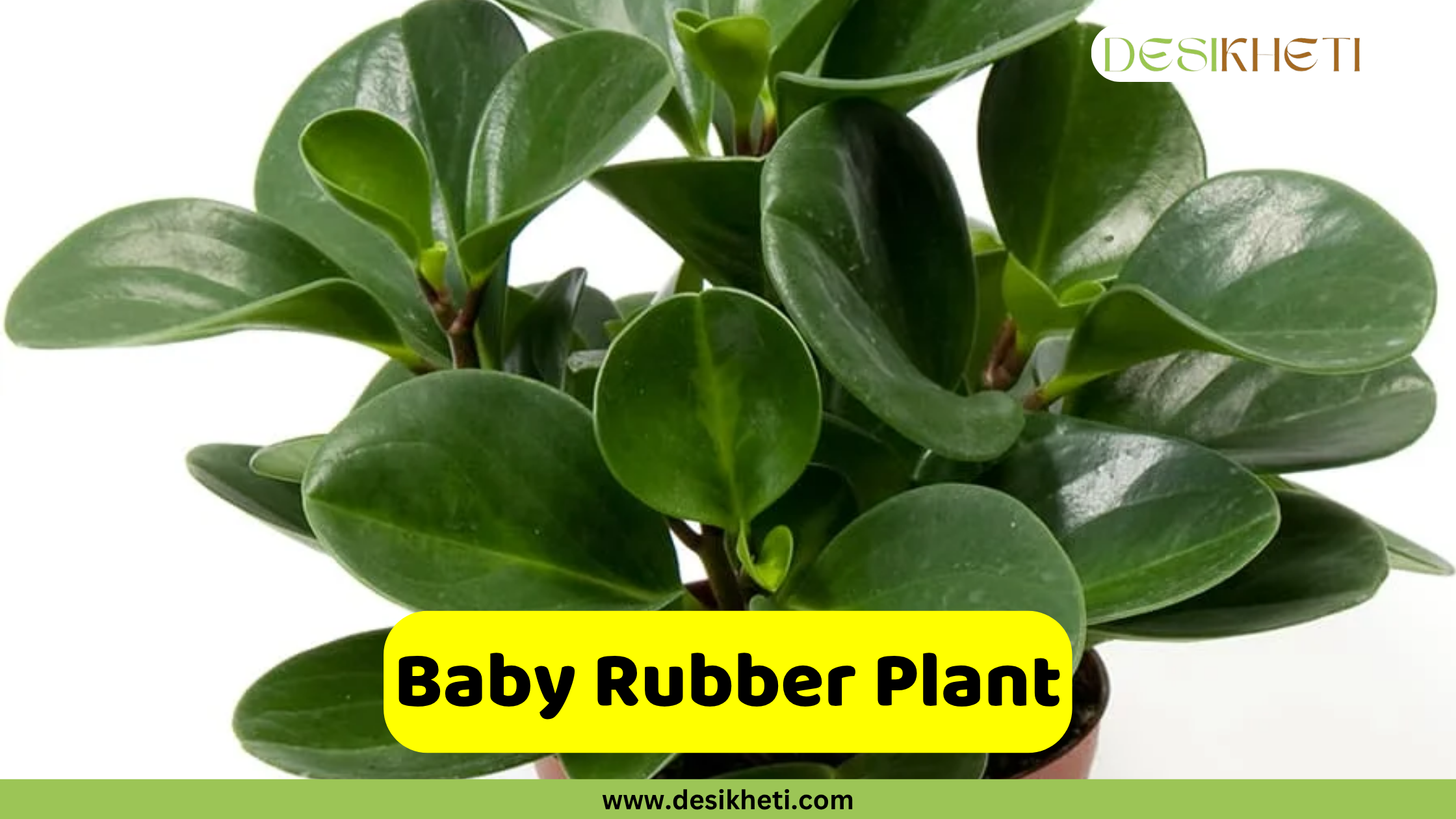
Botanical Name: Peperomia obtusifolia
A small, bushy plant that typically reaches up to 12 inches indoors. It features thick, succulent-like, glossy green leaves; some varieties are variegated with cream or yellow. Its compact size makes it perfect for small spaces like desktops and shelves.
Thrives in bright, indirect light but also tolerates low-light conditions. Water when the top 1–2 inches of soil are dry, and reduce watering during winter. Prefers moderate humidity and temperatures .
Benefits
- May contribute to indoor air purification
- Easy-care plant, ideal for busy or beginner plant parents
- Attractive foliage adds lush greenery to interiors
Ponytail Palm
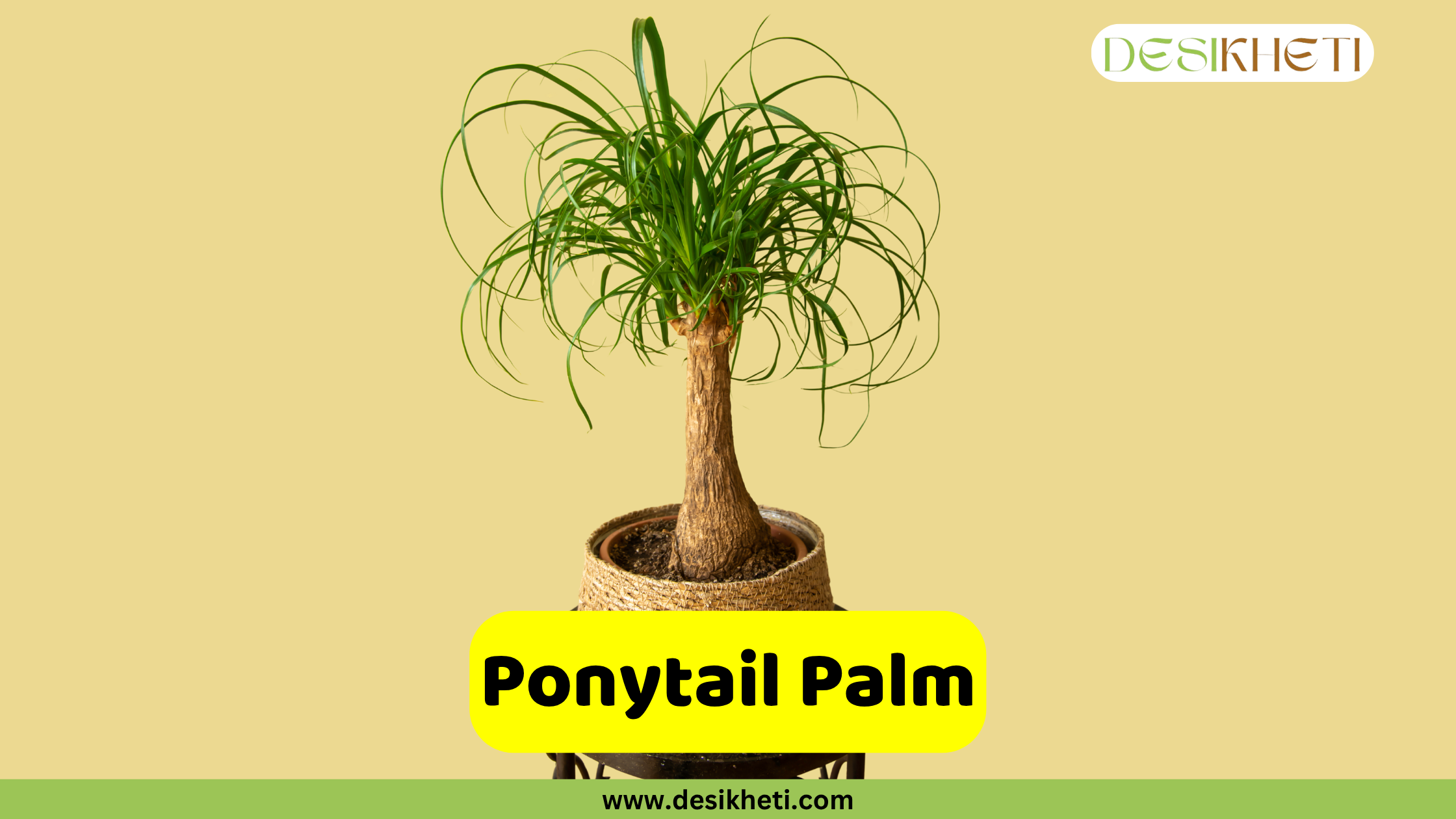
Botanical Name: Beaucarnea recurvata
Not a true palm, this plant has a swollen, water-storing base (caudex) and long, narrow, arching leaves that resemble a ponytail. It can grow 3–4 feet tall indoors and is slow-growing.
Place in a bright, well-lit area such as living rooms or sunrooms, with indirect or partial direct light. Allow the top 1–2 inches of soil to dry out before watering.
Want to explore more Palm Tree varieties? Read: 15 Types of Palm Tree Varieties That Beautify Your Home
Benefits
- Visually unique with a sculptural aesthetic appeal
- Hardy, low-maintenance plant perfect for beginners
- May help reduce indoor air pollutants
Peace Lily
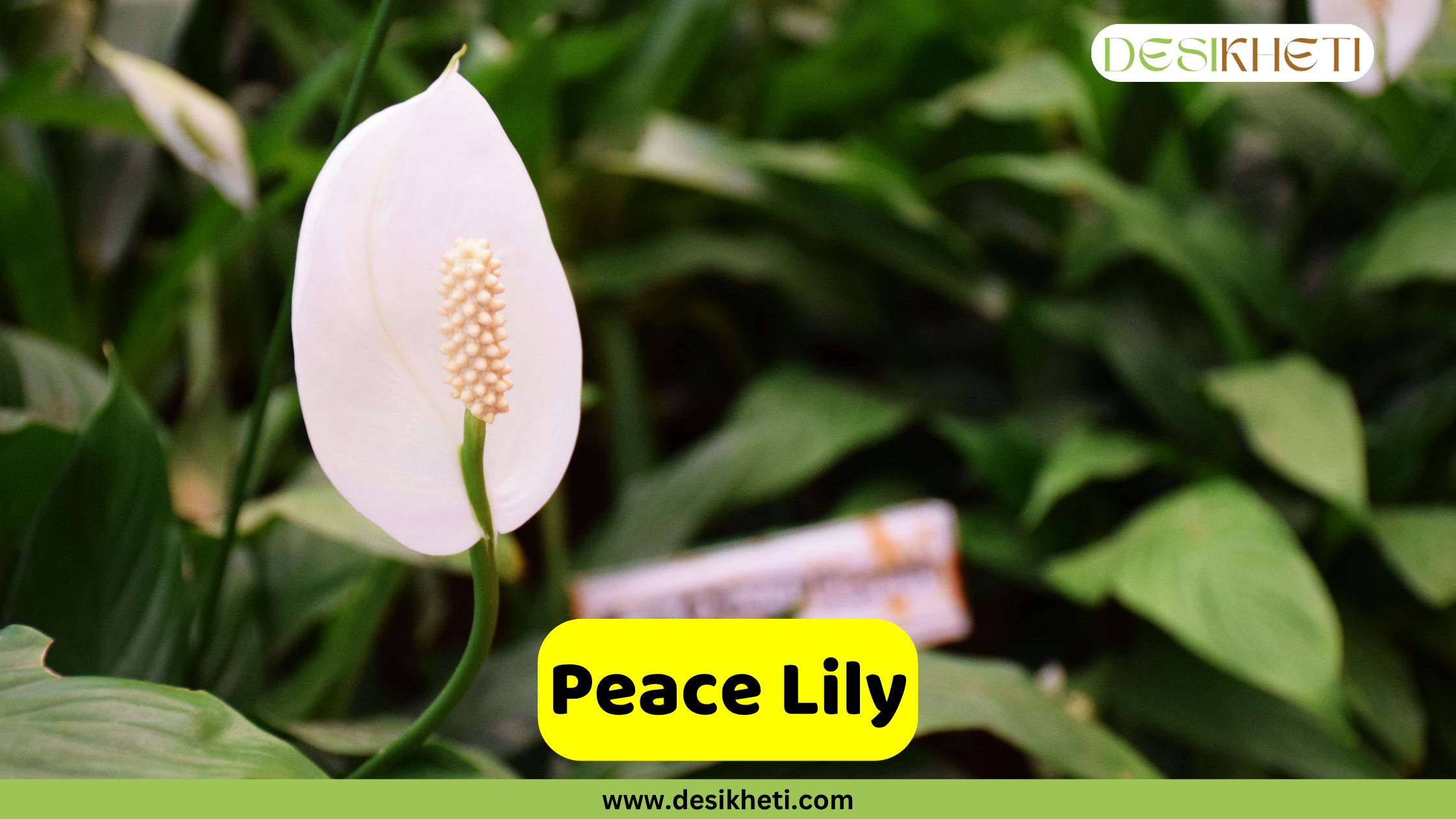
Botanical Name: Spathiphyllum wallisii
An elegant, low-light indoor plant with glossy, dark green leaves and striking white, sail-like spathes that resemble flowers. Typically grows 1–4 feet tall and spreads in clumps. It blooms periodically throughout the year, especially in spring.
Best placed in areas with low to moderate indirect sunlight. Avoid direct sun, as it can scorch the leaves. Thrives in evenly moist soil and benefits from occasional misting to maintain humidity.
Want to explore more Indoor Flowering Plant varieties? Read: 25 Best Indoor Flowering Plants for Indian Homes
Benefits
- Purifies air by removing toxins like ammonia, benzene, and formaldehyde
- Adds aesthetic and calming value to homes, offices, and hospitals
- Easy to care for and widely recommended for beginners
Toxicity
- Toxic to pets and mildly toxic to humans if ingested; may cause irritation, drooling, or stomach upset. Keep out of reach of children and animals.
Dracaena
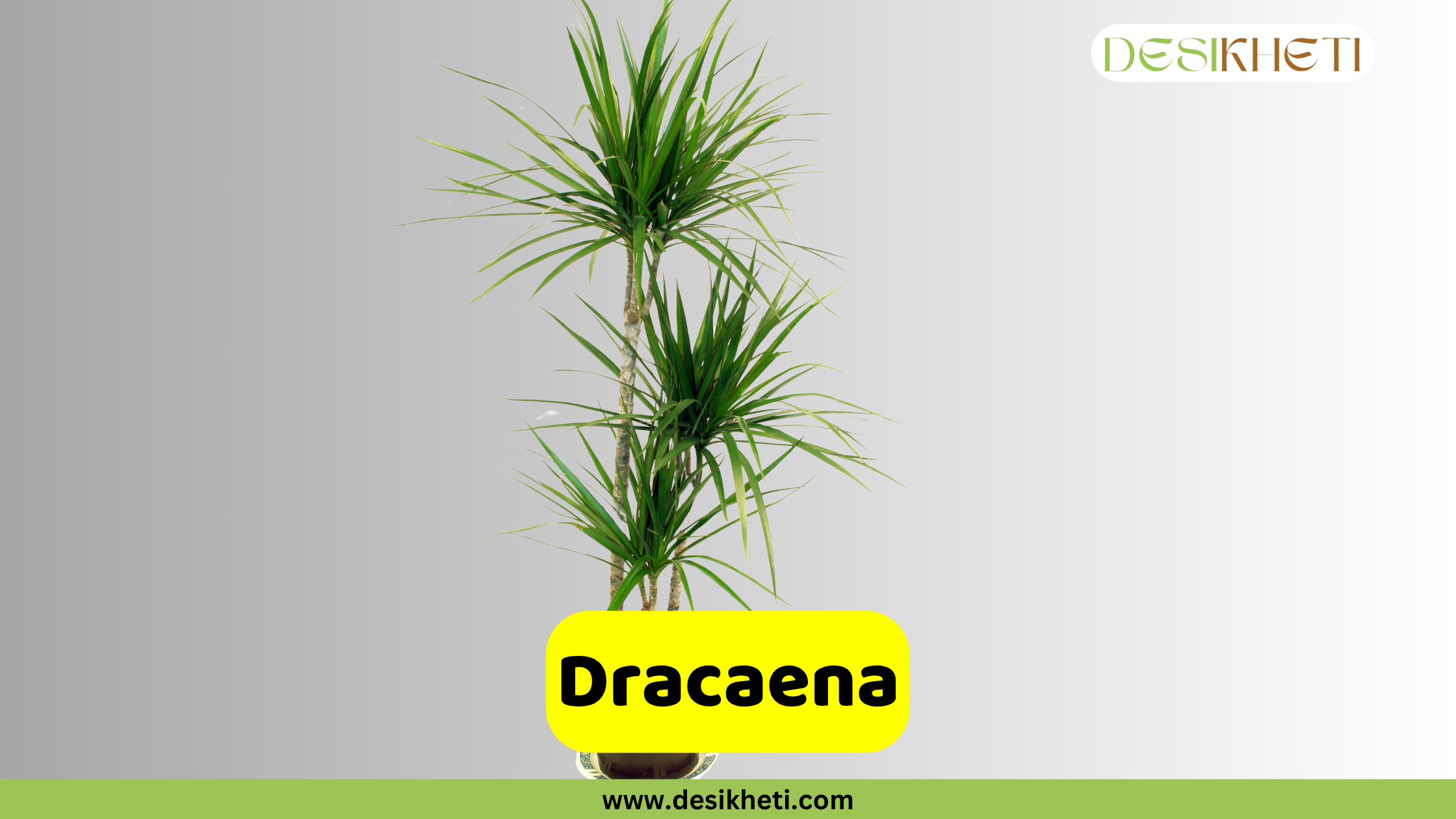
Botanical Name: Dracaena marginata
A tall, upright indoor plant with long, narrow leaves edged in red or cream. It features a woody stem and a palm-like top, reaching up to 6 feet indoors. The foliage may be solid green or variegated, depending on the variety.
Prefers bright, indirect light. It tolerates lower light but grows best with moderate brightness. Avoid direct sun. Allow the top inch of soil to dry before watering.
Benefits
- Excellent air purifier, removing toxins like benzene and formaldehyde
- Adds vertical interest and a tropical aesthetic to interiors
- Low-maintenance and ideal for beginners or offices
Toxicity
- Toxic to pets if ingested, as it may cause vomiting or lethargy.
Anthurium (Flamingo Flower)
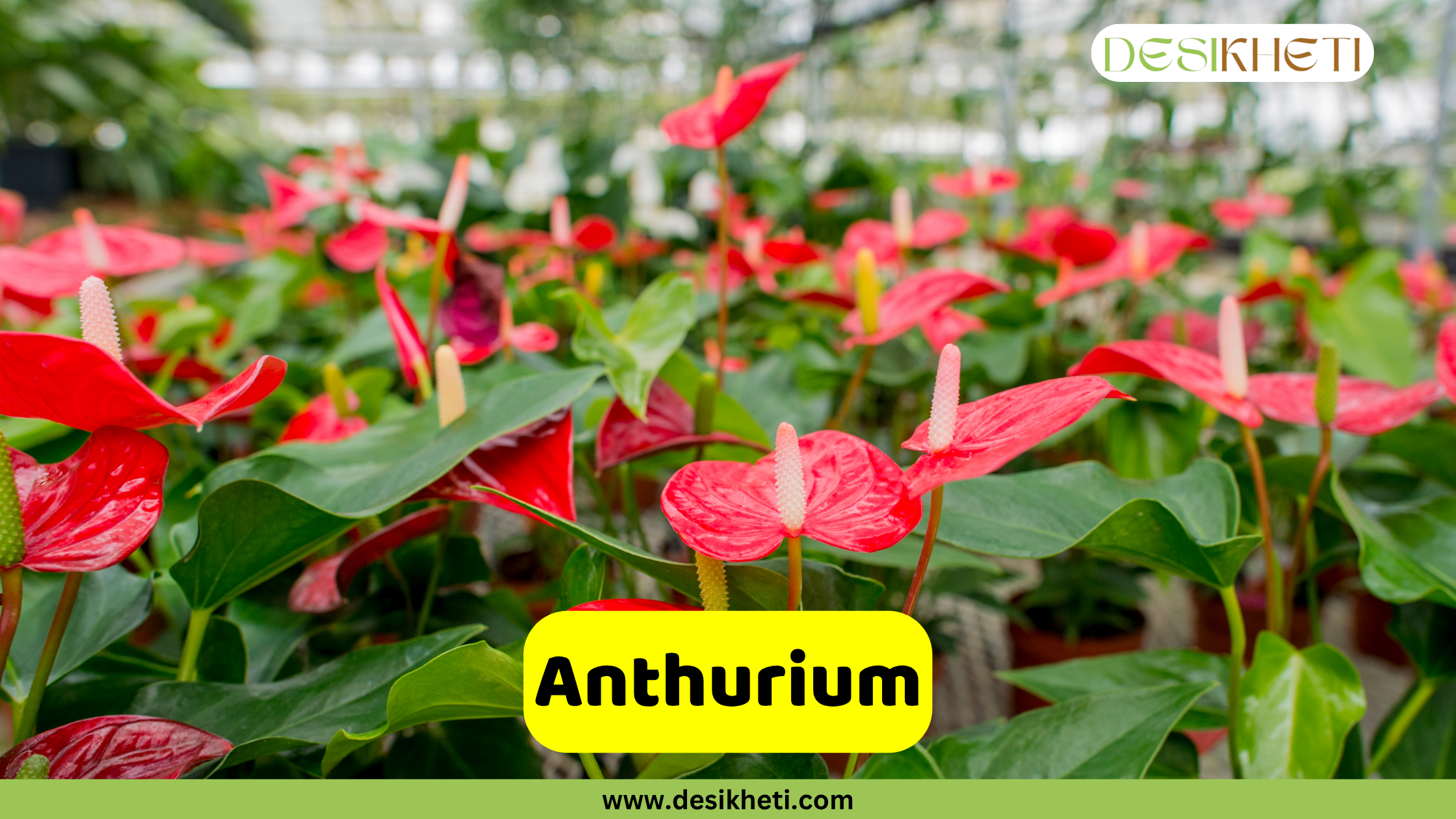
Botanical Name: Anthurium andraeanum
A vibrant flowering plant with large, glossy green leaves and brightly colored spathes (modified leaves) in red, pink, or white. Compact in size, typically growing up to 18 inches tall.
It grows well in bright, indirect light. Avoid direct sunlight. It requires high humidity and evenly moist soil.
Want to explore more Indoor Flowering Plant varieties? Read: 25 Best Indoor Flowering Plants for Indian Homes
Benefits
- Purifies indoor air by removing harmful toxins
- Long-lasting flowers enhance indoor aesthetics
- Bright colors can uplift mood and ambiance
Toxicity
- Toxic to pets and humans if ingested due to calcium oxalate crystals.
Interesting Fact
The Anthurium is often called the “Flamingo Flower” because its vibrant, heart-shaped spathes (the colorful, waxy leaf-like structures) resemble the bright plumage of flamingos. With colors like deep red, pink, or white, and an upright, elegant posture, the plant visually mimics the graceful appearance of a flamingo standing tall hence the name!
Croton
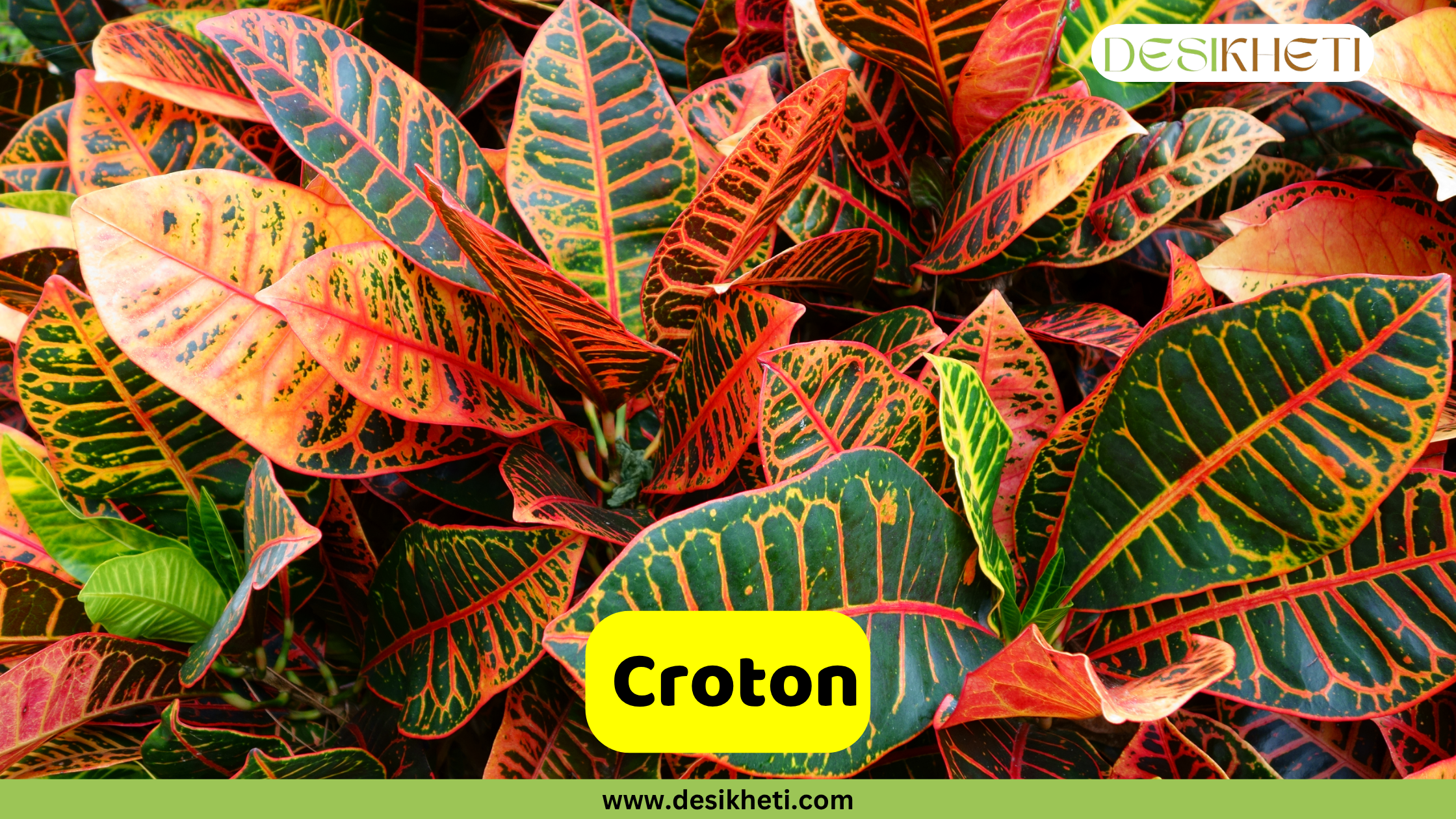
Botanical Name: Codiaeum variegatum
A striking indoor plant known for its vibrant, leathery leaves in shades of green, yellow, red, orange, and purple. The foliage comes in various shapes twisted, narrow, broad, or lobed. Crotons grow upright and can reach up to 3–4 feet indoors, adding a bold, tropical look to any space.
Best placed near an area with bright, indirect sunlight. Direct sunlight enhances the leaf coloration.
Benefits
- Enhances interior decor with its colourful, ornamental foliage
- Acts as a natural air purifier by absorbing indoor pollutants
Toxicity
- Toxic to pets and humans; ingestion may cause irritation, vomiting, or stomach discomfort. Sap may also irritate skin. Keep away from children and animals.
Dieffenbachia (Dumb Cane)
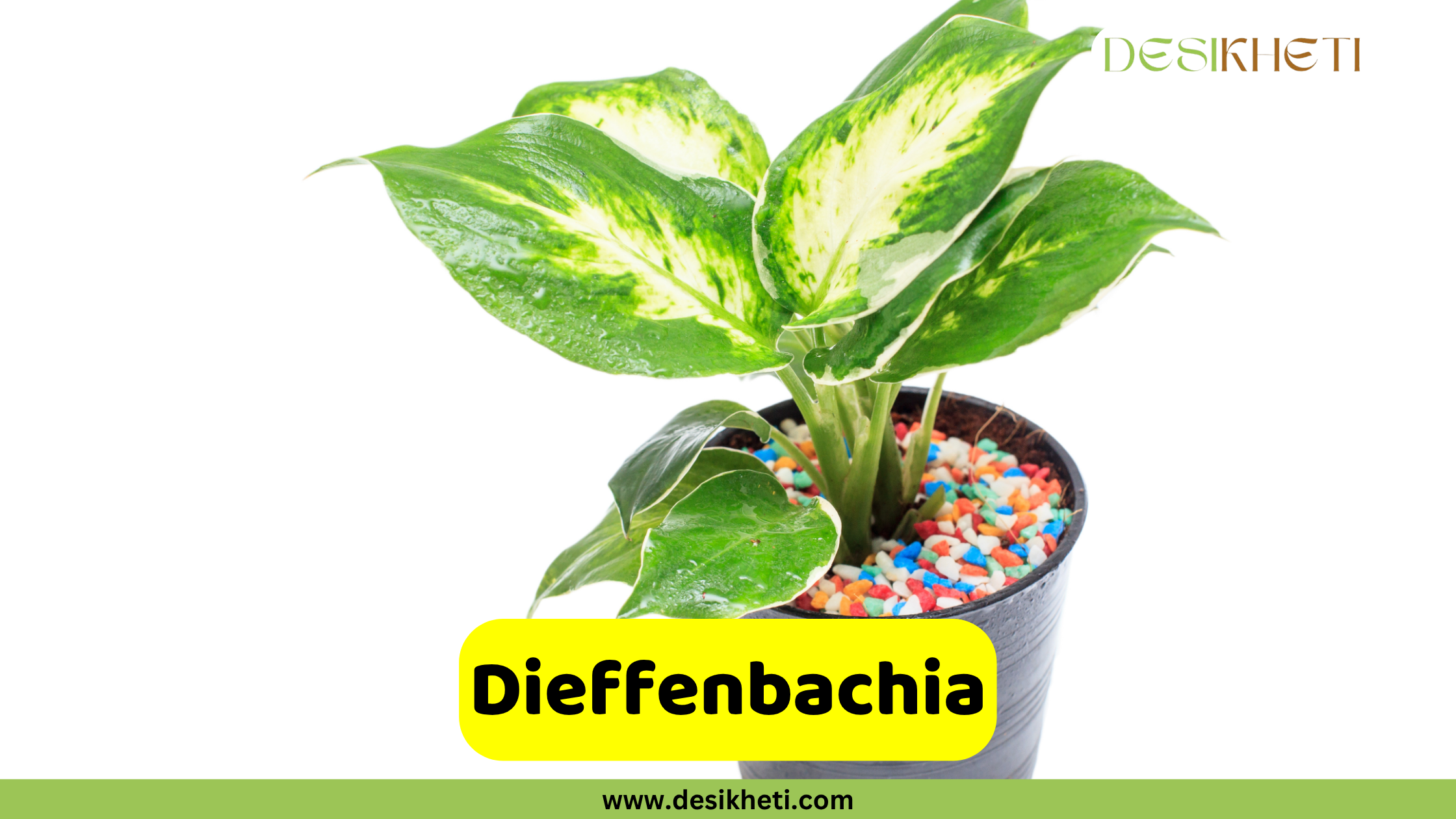
Botanical Name: Dieffenbachia spp.
A striking indoor plant known for its lush, patterned foliage and strong visual presence, featuring large variegated leaves in shades of green, cream, or yellow. It grows up to 3–5 feet tall, with a bushy structure and thick stems.
Best placed windows with bright, indirect light. Avoid direct sunlight. Keep the soil slightly moist and ensure good drainage.
Benefits
- Acts as a natural air filter, removing indoor toxins
- Visually striking with dramatic foliage
- Requires minimal maintenance
Toxicity
- Toxic to pets and humans. Ingestion can cause severe mouth and throat irritation, swelling, and temporary loss of speech due to calcium oxalate crystals; keep out of reach.
Interesting Fact
Dieffenbachia is commonly called “Dumb Cane” because its sap contains calcium oxalate crystals, which can cause temporary loss of speech if ingested. When the sap comes into contact with the mouth or throat, it can cause intense irritation, swelling, and difficulty speaking hence the nickname “Dumb Cane.”
Parlor Palm
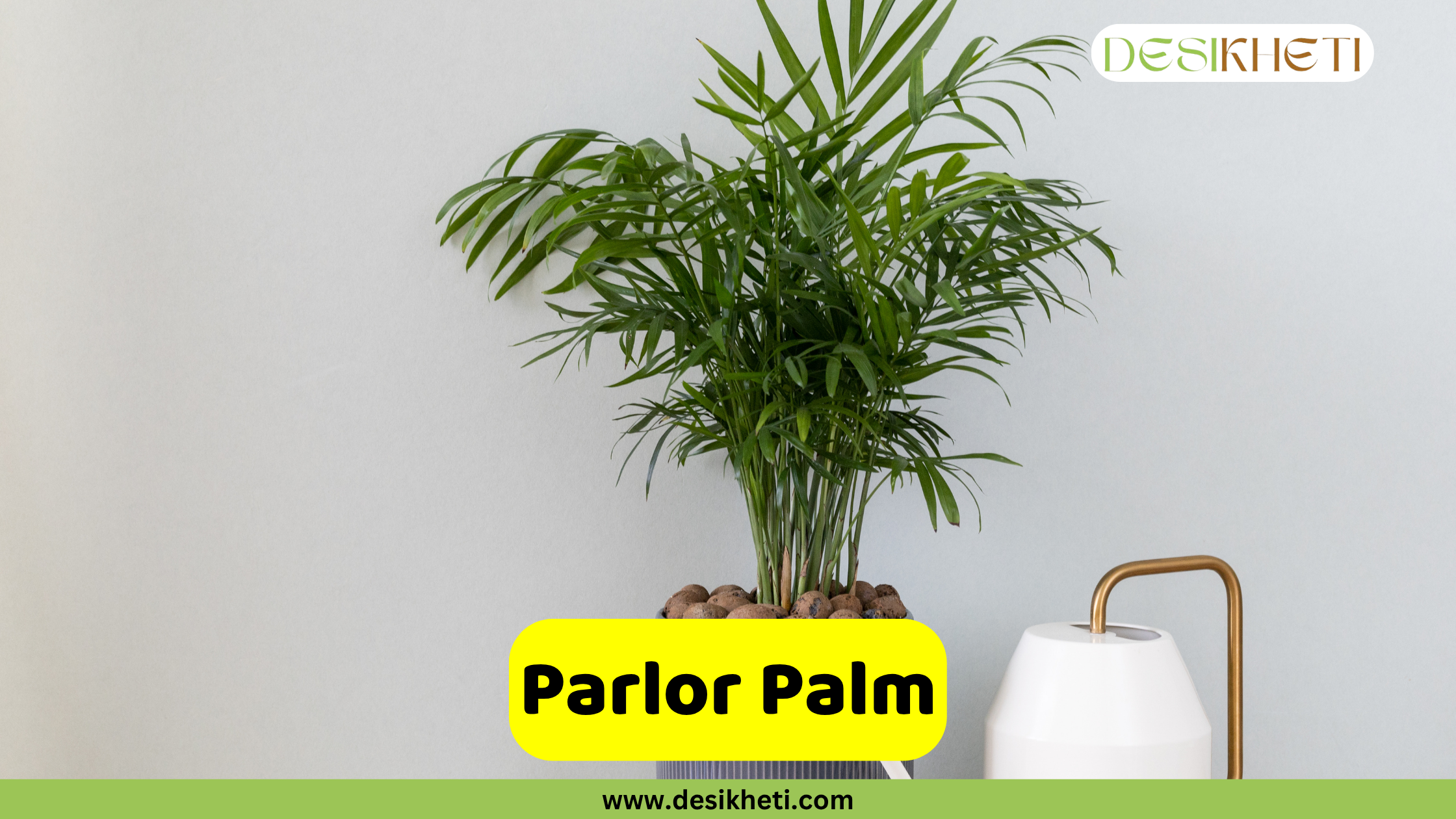
Botanical Name: Chamaedorea elegans
A graceful, slow-growing indoor palm with slender green stems and delicate, feather-like fronds. Typically grows 2–4 feet tall indoors, forming small clumps that give it a soft, bushy appearance. Well-suited for tabletops, shelves, or floor pots in homes and offices.
Ideal for rooms with low to moderate indirect light. Thrives in filtered light and shaded indoor corners. Requires well-drained soil.
Want to explore more Palm Tree varieties? Read: 15 Types of Palm Tree Varieties That Beautify Your Home
Benefits
- Purifies indoor air by filtering out pollutants like carbon monoxide and benzene
- Popular for minimalist or tropical-themed interiors
- Excellent for workspaces due to its low light tolerance and compact growth
Calathea

Botanical Name: Calathea spp.
Known for its patterned, decorative leaves in shades of green, purple, and white, often with a purple underside. Grows up to 1–3 feet tall. Leaves fold slightly at night.
Prefers low to bright indirect light. Avoid direct sunlight. Keep the soil consistently moist using distilled or non-chlorinated water.
Benefits
- Improves air quality
- Stunning foliage adds vibrant, tropical charm
Jade Plant

Botanical Name: Crassula ovata
A succulent with thick, fleshy, oval-shaped leaves that may develop red edges in sunlight. Grows up to 3–6 feet indoors and has a bonsai-like appearance.
Requires 4–6 hours of bright, indirect sunlight. Allow the soil to dry out completely between waterings.
Benefits
- CAM plant: absorbs CO₂ at night, helping improve indoor air quality
- Low-maintenance and drought-tolerant
- Often considered a symbol of prosperity and good luck
Toxicity
- Toxic to cats and dogs; mildly toxic to humans.
Philodendrons

Botanical Name: Philodendron spp.
Tropical-looking plants with heart-shaped or lobed leaves; available in both climbing/vining and upright forms. Size varies by species but generally remains compact indoors. Known for lush foliage and easy care.
Best placed near windows with bright, indirect light. Can tolerate lower light, but avoid direct sunlight to prevent leaf burn. Water when the top inch of soil is dry.
Benefits
- Removes formaldehyde from indoor air
- Easy to grow and beginner-friendly
- Creates a relaxing, green atmosphere that may help reduce stress
Toxicity
- Toxic to pets and humans if ingested; may cause mouth, throat, or skin irritation.
Flowering Indoor Plants
- Peace Lily
- Anthurium
For more information, you can check out – 25 Best Indoor Flowering Plants for Indian Homes.
Air-Purifying / High-Oxygen Indoor Plants
- Areca Palm
- Snake Plant
- ZZ Plant
- Rubber Plant
- Bamboo Palm
- Spider Plant
- Peace Lily
- Dracaena
- Parlor Palm
- Philodendrons
Low-Light Indoor Plants
- ZZ Plant
- Chinese Evergreen
- Snake Plant
- Peace Lily
- Calathea
- Philodendrons
- Dieffenbachia
- Parlor Palm
Low-Maintenance Indoor Plants / Easy Growers
- Snake Plant
- ZZ Plant
- Aloe Vera
- Spider Plant
- Ponytail Palm
- Jade Plant
- Rubber Plant
Succulents and Cacti for Indoors
- Aloe Vera
- Jade Plant
- Ponytail Palm
For a detailed list, check out our blog on 15 Best Succulent Plants
Tall Indoor Plants
- Areca Palm
- Rubber Plant
- Fiddle Leaf Fig
- Bamboo Palm
- Dracaena
Tabletop / Small Indoor Plants
- Baby Rubber Plant
- Spider Plant
- Prayer Plant
- Bird’s Nest Fern
- Jade Plant
- Anthurium
- Calathea
Climbers and Creepers for Indoors
- English Ivy
- Philodendrons
Indoor plants offer much more than just visual appeal; they bring freshness, tranquility, and improved air quality to our living and working spaces.
Selecting the right indoor plants according to your light conditions, care preferences, and aesthetic taste can enhance your home’s atmosphere while also providing tangible health benefits. Whether you choose hardy succulents or lush tropical foliage, cultivating indoor greenery can create a peaceful sanctuary that connects you with nature every day.
Start small, enjoy the process, and watch your indoor garden flourish, turning your space into a vibrant, healthy haven.
So, which indoor plant are you excited to bring home first?
Are you leaning towards a low-maintenance buddy like the Snake Plant or something colorful and lively like the Prayer Plant? Maybe a statement plant like the Fiddle Leaf Fig?
Share your choice in the comments below.
You may also like: 15 Popular Types of Orchids in India, 15 Stunning Types of Hydrangeas for Your Garden
FAQs on Indoor Plants
1. What is special about Areca Palm?
A. Areca Palm is an elegant, air-purifying plant known for its feathery fronds, making it ideal for indoor décor and improving humidity levels.
2. What is the snake plant famous for?
A. Snake Plant is famous for its air-purifying ability and tolerance to low light and neglect; it also releases oxygen at night.
3. What are the interesting facts about money plants?
A. Money plants are believed to bring good luck and prosperity. They can grow in water or soil and purify indoor air.
4. Can spider plants survive indoors?
A. Yes, spider plants thrive indoors, even in low light. They’re resilient, air-purifying, and ideal for beginners.
5. Is spider plant a lucky plant?
A. Yes, spider plants are considered lucky in many cultures due to their positive energy and health-boosting qualities.
6. Do spider plants grow fast?
A. Yes, spider plants grow quickly and produce offshoots or “babies” that can be propagated easily.
7. How quickly do rubber plants grow?
A. Rubber plants grow moderately fast, often adding several inches in height per year with proper light and care.
8. What is another name for Chinese evergreens?
A. Chinese evergreens are also known as Aglaonema.
9. What are fiddle leaf figs known for?
A. Fiddle leaf figs are known for their large, glossy, violin-shaped leaves and bold statement in interior design.
10. What are the special features of philodendrons?
A. Philodendrons are low-maintenance, fast-growing plants with trailing or upright varieties, great for purifying air and adding greenery indoors.
11. What are some interesting facts about English ivy?
A. English ivy improves indoor air quality, climbs walls or trails from baskets, and is even used in traditional medicine.
12. How long do bamboo palms last?
A. Bamboo palms can live 5 to 10 years indoors with proper care and conditions.
13. What is another name for a Bamboo Palm?
A. Bamboo Palm is also known as Chamaedorea seifrizii.
14. What are the interesting facts about prayer plants?
A. Prayer plants fold their leaves up at night like hands in prayer and are known for their vibrant, patterned foliage.
15. What is another name for a prayer plant?
A. The prayer plant is also called Maranta leuconeura.
16. What are the benefits of Baby Rubber Plant?
A. Baby Rubber Plants are non-toxic, air-purifying, and compact making them perfect for small indoor spaces.
17. What are the fun facts about ponytail palms?
A. Despite the name, ponytail palms are not true palms. They store water in their bulbous base and can survive drought for weeks.
18. What are some interesting facts about Dracaena?
A. Dracaena comes in many varieties, filters toxins from the air, and thrives in low to medium light conditions.
19. What is special about anthuriums?
A. Anthuriums are prized for their shiny heart-shaped leaves and long-lasting red, pink, or white blooms.
20. What is special about Calathea?
A. Calatheas are known for their striking leaf patterns and movement; their leaves close at night and open by day.
21. What is special about the jade plant?
A. Jade plants are succulents symbolizing good fortune and wealth, and they require minimal watering to thrive.
22. What are the interesting facts about crotons?
A. Crotons are loved for their colorful, variegated leaves. They need bright light to maintain vivid colors and can grow into small shrubs indoors.
